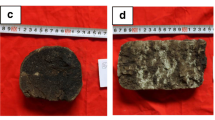Abstract
Combined development of oil and salt layers of the oil field allows to obtain a mineralized solution to intensify the extraction of oil from the reservoir and create an underground reservoir in the salt reservoir for underground storage of hydrocarbons, including the creation of an underground gas storage (UGS) in rock salt.
You have full access to this open access chapter, Download conference paper PDF
Similar content being viewed by others
Keywords
1 Introduction
The complex development of deposits and the most complete use of the resource potential of the developed deposits, as well as the multifunctional use of the waste space of mineral deposits, is one of the main tasks of mining science (Vorob’ev et al. 2017).
In a number of oil fields, the screen is a salt layer of various capacities located above the productive oil reservoir, which can be used to produce mineralized water with subsequent injection of mineralized water into the productive oil reservoir, and the production-capacity (underground reservoir) formed in the salt reservoir can serve as a storage of hydrocarbons extracted from the productive reservoir (natural gas, associated oil gas, oil).
2 Methods and Approaches
To obtain mineralized water, it is advisable to drill wells on the salt formation and conduct underground dissolution of rock salt to obtain a solution of rock salt of a certain concentration for injection through injection wells into the productive formation and extraction of oil from the productive formation through producing wells.
Pumping more fresh water into the clay-containing collector than the reservoir water reduces the permeability of the collector and makes it a low-permeable collector. Controlling the mineralization of injected water and the properties of clays in productive formations can significantly increase the oil recovery rate.
3 Results and Discussion
The use of mineralized water can reduce the hydration of formation clays, but it is desirable to select the composition of water that is most compatible with the formation components of the productive formation.
The use of mineralized water obtained by dissolving the salt layer of the oil field can largely solve the problem of compatibility of pumped mineralized water with reservoir water and mineral composition of the reservoir (Lyashenko et al. 2018).
When developing a salt formation with a capacity of several tens of meters with the supply of solvent through the drilling well, according to the technological regulations, an underground production is created-a container in rock salt (vertical or horizontal) for storage of petroleum gas along the way.
4 Conclusions
Complex use of oil and salt layers of the oil field allows to obtain a mineralized solution to intensify the extraction of oil from the reservoir and to create an underground reservoir in the salt reservoir for underground storage of associated petroleum gas (APG), i.e. to create an underground gas storage (UGS) in rock salt.
At Talakan oil and gas condensate field (Republic of Sakha) the implementation of combined development of oil and salt layers of oil and gas condensate field with the creation of an underground gas storage in rock salt and the use of mineralized solution for the intensification of oil extraction was started.
References
Lyashenko V, Vorob’ev A, Nebohin V, Vorob’ev K (2018) Improving the efficiency of blasting operations in mines with the help of emulsion explosives. Min Miner Deposits 1:95–102
Vorob’ev A, Chekushina T, Vorob’ev K (2017) Russian national technological initiative in the sphere of mineral resource usage. Rudarsko Geolosko Naftni Zbornik. 2:1–8
Author information
Authors and Affiliations
Corresponding author
Editor information
Editors and Affiliations
Rights and permissions
Open Access This chapter is licensed under the terms of the Creative Commons Attribution 4.0 International License (http://creativecommons.org/licenses/by/4.0/), which permits use, sharing, adaptation, distribution and reproduction in any medium or format, as long as you give appropriate credit to the original author(s) and the source, provide a link to the Creative Commons license and indicate if changes were made.
The images or other third party material in this chapter are included in the chapter's Creative Commons license, unless indicated otherwise in a credit line to the material. If material is not included in the chapter's Creative Commons license and your intended use is not permitted by statutory regulation or exceeds the permitted use, you will need to obtain permission directly from the copyright holder.
Copyright information
© 2019 The Author(s)
About this paper
Cite this paper
Malyukov, V., Vorobyev, K. (2019). Integrated Use of Oil and Salt Layers at Oil Field Development. In: Glagolev, S. (eds) 14th International Congress for Applied Mineralogy (ICAM2019). ICAM 2019. Springer Proceedings in Earth and Environmental Sciences. Springer, Cham. https://doi.org/10.1007/978-3-030-22974-0_53
Download citation
DOI: https://doi.org/10.1007/978-3-030-22974-0_53
Published:
Publisher Name: Springer, Cham
Print ISBN: 978-3-030-22973-3
Online ISBN: 978-3-030-22974-0
eBook Packages: Earth and Environmental ScienceEarth and Environmental Science (R0)



